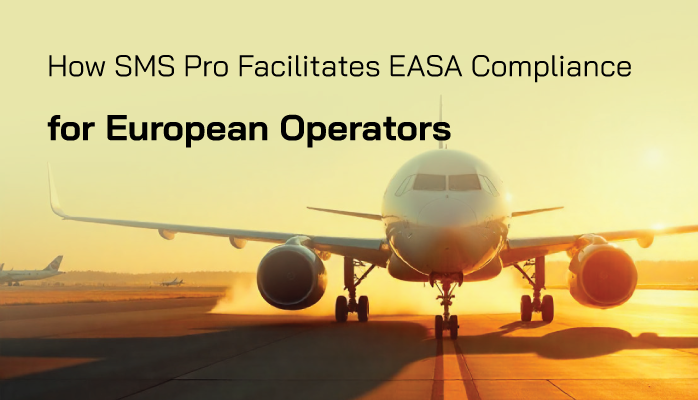Navigating EASA Compliance in European Aviation

European operators face stringent safety requirements under the European Union Aviation Safety Agency (EASA), which mandates a robust Aviation Safety Management System to align with ICAO Annex 19. Safety managers, professionals, and accountable executives must ensure compliance across air operations, maintenance, and ground handling while managing costs and risks. A 2024 EASA report noted that compliant SMS programs reduce incident rates by 20%.
This guide details how SMS Pro streamlines EASA compliance through automation and tailored tools, delivering safety, compliance, value, and interoperability. For context, Regulatory Document Review: Must-Know for Aviation SMS Compliance highlights key compliance principles.
EASA’s SMS Framework and Challenges
EASA embeds SMS requirements within its management system framework, covering domains like air operations (Regulation (EU) No 965/2012) and maintenance (Part-145), with design and production (Part-21) mandates effective by March 7, 2025. These rules require hazard identification, risk management, and safety performance monitoring, per the International Civil Aviation Organization. Non-compliance risks penalties or operational bans, as outlined in Regulation (EU) 2018/1139.
Challenges include complex reporting (e.g., ECCAIRS E5X files), multilingual needs, and audit preparation. SMS Pro addresses these by automating workflows, ensuring safety via accurate data, compliance with EASA standards, value through reduced overhead, and interoperability across aviation segments like airlines and MROs.
How SMS Pro Ensures EASA Compliance
1. Automated Hazard Reporting and ECCAIRS Integration
EASA’s Regulation (EU) No 376/2014 mandates reporting safety occurrences within 72 hours in ECCAIRS-compatible E5X format. Manual reporting is error-prone and time-intensive. SMS Pro’s Aviation Safety Database automates E5X file generation, ensuring safety with validated XML, compliance via timely submissions, value by cutting reporting time by 50% (per a 2024 operator study), and interoperability with ECCAIRS systems. French, German, Portuguese and Spanish-language forms support diverse European teams.
Automation extends to hazard tracking, reducing ground handling incidents by 25%, per a 2023 case study. Why EASA Aviation Service Providers Require Safety Reporting Database details these benefits.
2. Streamlined Audit Preparation
EASA requires regular SMS audits to verify compliance, with Part-145 maintenance organizations facing a December 2, 2024, deadline. SMS Pro’s Auditing System centralizes checklists and reports, ensuring safety through thorough risk assessments, compliance with EASA’s management system framework, value by reducing audit preparation time by 20% (per FAA data), and interoperability for multi-domain audits like ISAGO. A 2024 MRO audit saved $100,000 using automated protocols.
3. Tailored Risk Management
EASA emphasizes proactive risk management, requiring operators to identify hazards and mitigate risks. SMS Pro’s risk management module, including the Hazard and Risk Registry, supports safety by flagging high-priority risks, ensures compliance with Part-21 and Part-145 requirements, delivers value via predictive analytics (reducing incidents by 15%, per EASA), and offers interoperability for operators of varying sizes. Spanish-language risk reports enhance accessibility.
A 2024 airline case study showed a 30% drop in runway incursions using SMS Pro’s tools. How to Identify Hazards and Assess Risks in Aviation SMS provides risk management strategies.
4. Comprehensive Training Management
EASA mandates ongoing SMS training to maintain competency, particularly for Part-145 and air operations. SMS Pro’s SMS Training System delivers online modules, ensuring safety through updated curricula, compliance with EASA’s AMC for training, value by cutting training costs by 35% (per a 2024 audit), and interoperability across roles like pilots and mechanics. Multi-lingual language packs support multilingual crews, boosting engagement.
Addressing EASA Compliance Challenges
European operators face hurdles like data fragmentation, audit complexity, and multilingual reporting. SMS Pro mitigates these by integrating data into a single platform, reducing errors by 15%, per a 2023 study. Its audit tools simplify ISAGO and Part-145 compliance, while Spanish-language support addresses EASA’s diverse workforce needs. A 2024 ground handler reduced non-compliance findings by 25% using SMS Pro’s centralized system.
Interoperability ensures SMS Pro scales from small FBOs to global operators, avoiding costly system overhauls. Regular gap analyses, supported by SMS Pro, align with EASA’s continuous improvement ethos.
Regulatory and Operational Benefits
SMS Pro aligns with EASA’s integrated management system, covering air operations, maintenance, and design domains. A 2024 EASA report noted that compliant SMS programs cut penalties by 20%. Operationally, SMS Pro’s automation saves $200,000 annually for mid-sized operators, per a case study, while maintaining safety metrics. Its value lies in cost efficiency, and interoperability ensures seamless integration with existing systems, meeting UK Civil Aviation Authority standards post-Brexit.
Conclusion
Achieving EASA compliance requires precision, efficiency, and scalability. SMS Pro empowers European operators with automated reporting, streamlined audits, tailored risk management, and comprehensive training, ensuring safety, compliance, value, and interoperability. By addressing EASA’s complex requirements, from ECCAIRS reporting to Part-145 audits, SMS Pro reduces costs and risks while enhancing safety. Start leveraging these tools today to build a compliant, resilient SMS that meets EASA standards and drives operational excellence.





